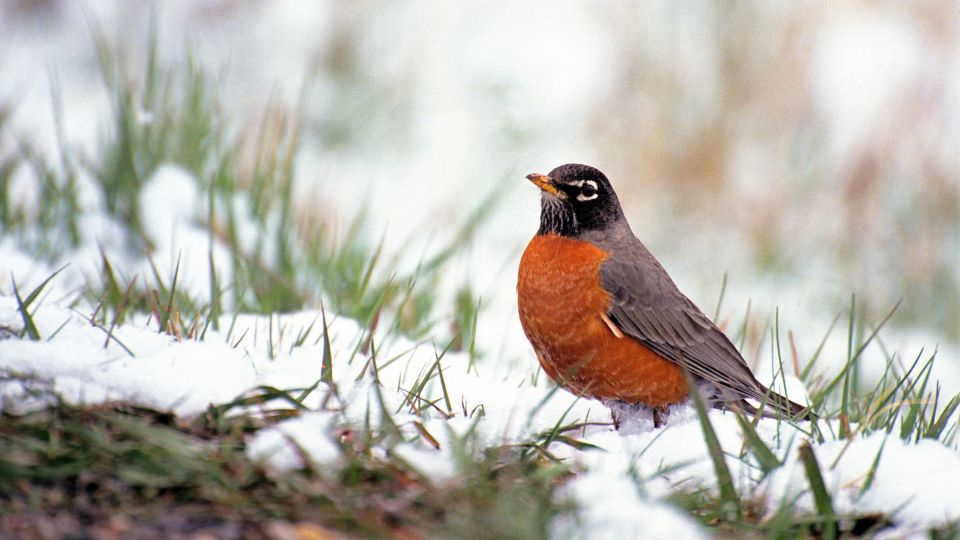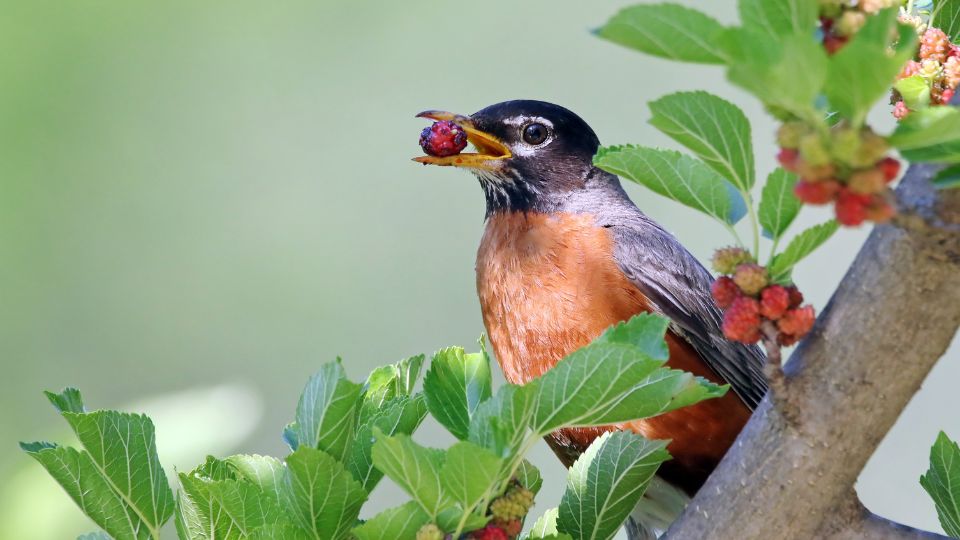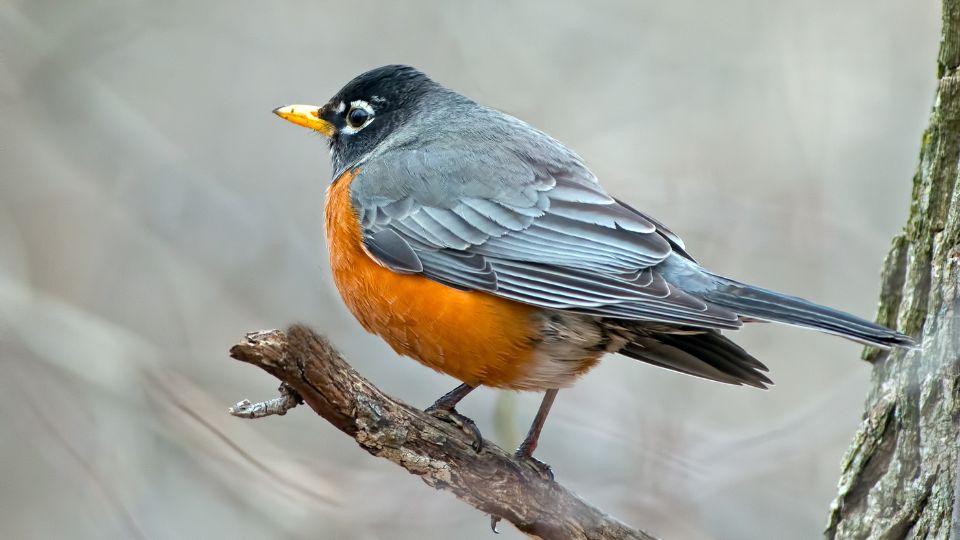Americans Robins migrate during the winter, usually down towards North Texas and Florida. They migrate not because of the cold weather but because the South continues to have ample food supply.
American Robins can withstand cold temperatures as they are known to add more feathers to their plumage during the cold winter season. Some Robins will even stay up north during the winter, especially defending their territory from other rival Robins.
American Robins can be long-distance migrants, intermediate travelers, or typically remain the same place all year round. Wisconsin robins are large flocks of robins who travel with other migratory birds like hummingbirds from Vancouver Island to as far south as Guatemala in search of warmer climates where they can easily find their food sources. Other birds found in southern Mexico and Baja California areas do not migrate.
The American Robin does not follow the same migratory paths every year as other bird species. American robins often gather together and migrate southwards, looking for trees, berries, bushes, and earthworms.

How Do Robins Know When to Migrate?
The timing of bird migrations is an intriguing natural phenomenon that is still a mystery.
Some sources state that Robins migrate depending on the duration of daylight, as days become shorter, robins may begin to fly southward. Robins will also migrate when food sources, such as earthworms become less accessible.
Environmental conditions like climate change often determine the migration ecology of these migrants. Weather variations necessitate these birds to find better breeding grounds. The winter flocks’ migration can also be triggered by the depletion of food sources in the north.
In the video below, we rounded up 10 little known facts about Robins!
What Time of Year Do Robins Begin Migrating?
Most american robins migrate at the onset of winter, typically when the weather starts to change – around October. Robins migrate to areas in the south like Florida and Texas. During the winter, areas like Southern Canada experiences a shortage of robins. Due to this aspect, most people in northern regions refer to the first sight of robin birds during winter as a sign of spring.
Huge flocks of Robin birds migrate specifically for food and breeding grounds during the winter. This migration southwards, often towards the south, is to for survival. The robins often lose their regular food supply found in the ground such as grubs, worms, sod webworms, and chinch bugs.
During fall, Robin birds feed on berries and fruits, but in winter, they have to feed on as many earthworms and insects when the ground thaws. The depletion of these foods makes it necessary for robin birds to hibernate or migrate southward as they can feed on pellets and twigs from certain trees found in southern America, especially Florida.
Not all Robins are yearly migrants; some birds are known to stay put in a location and live there for an extended period. The birds will establish their territory by using their calls and specific songs.

Most of these year-round American Robins typically live in America’s woodland, parks, grasslands, and backyard regions. The birds have a notable preference for expansive land spaces and are also seen to occupy open fields of backyards and suburban playing grounds (at least 2,000 to 10,000 square yards of space).
The birds are generally friendly toward humans and tend to live closer to suburban and urban dwellings. The birds enjoy warm areas with ground-level trees to build their nests on. American Robins are known to start breeding in the spring, from April to July.
American Robins are the first birds to lay eggs at the beginning of the spring season. American Robins will lay approximately two to three batches (broods) of eggs each breeding season.
Does the American Robin Always Migrate South?
Nearly one-third of the total population of the American Robins travel yearly southwards toward Florida. The Southward-migration of winter flocks starts during the climatic periods of fall in October. The robin birds often travel from Canada to Mexico and the Gulf Coast during the cold season.
This is the period of mild weather when these backyard birds begin traveling southwards, seeking alternative weather conditions in warmer regions to provide a sustainable living environment for the altricial chicks.
The search is specifically for food and shelter during the oncoming rain and snowy seasons following America’s October weather. The birds are estimated to cover 100-200 miles within a single day of travel.
American Robins form flocks in the hundreds and sometimes thousands. Traveling in large flocks provides immense benefits for this avian species, including improved chances of spotting abundant food sources and avoiding predators.
The remaining two-thirds of Robin birds are referred to as year-round. These resident birds practice minimal nomadic lifestyles, only migrating some distance when continuous inclement weather and snowfall occur. The backyard birds are adapted to find alternative sources of food and warmth within these same regions without traveling further South to enjoy this benefit.
Female Robins will designate their territory and occupy the space, while the male robin provides security, company, and protection to the territory and hatchlings.
During any migration, the male-Robin bird is in charge of finding suitable regions and sub-groups of travelers to enhance security. The female Robin sets up the family’s nest as the male bird provides the leadership and protection of the family in the new territorial grounds during migration.
It is estimated that with every migratory season, the total population of the birds reduces by 20% during travel contributing to accidents and death. However, this loss affects the entire ecosystem of the birds as increased numbers of dead birds disrupt an active ecosystem.

How Long Does the Migration Take?
The birds follow the 37-degree isotherm when traveling, and it takes them 6-14 days to travel the distance. However, the birds never stop traveling throughout the year for comfort, exploration, or mates as the birds wander throughout the spring, winter, and autumn seasons.
Since weather and food are the main contributors to Robin birds’ travel, these factors also determine how long and far the travel distance is.
When the birds can quickly locate food and other favorable living conditions that serve an entire brood, they readily settle in this location and minimize further travel to other regions.
Where Are the American Robin Breeding Grounds?
Whether the Robins are migrants or residents of their respective locations, almost all can be found dwelling south of Canada. Some Robins will go down as far as Mexico, the Gulf Coast or the southwest to breed.
Female Robins are often in charge of choosing the nest sites, typically on one or several horizontal branches hidden in or just below a layer of dense leaves. New nests can typically be built on the tree’s lower half or on the treetop, where the nest is secured with leaves and branches. During nest-building, female Robins can further camouflage the new nests with feathers and twigs.
For other Robin birds, the breeding grounds can place in gutters, on the ground, or other structures as long as they are near food sources necessary for the survival of the new hatchlings. However, the lower breeding grounds can be attacked by squirrels, snakes, and other birds known to eat robin eggs and chicks.

